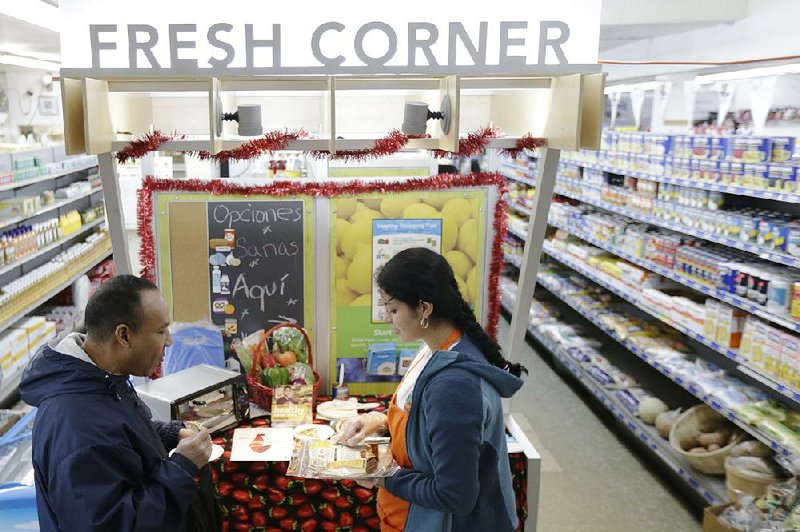PHILADELPHIA - From the outside, Carmen Medina’s convenience store appears to be an oasis in the food desert of gritty north Philadelphia, from its bright-yellow-and-white-striped awnings to the fake palm tree sculptures on the sidewalk.
A glimpse inside proves the image is no mirage. The Indiana Food Market is part of the Healthy Corner Stores Network, which aims to teach residents about nutritious eating through grocery promotions and outreach efforts like cooking demonstrations.
Customers were recently offered slices of pizza made on-site with store-bought ingredients: whole-wheat tortillas, tomato sauce, part-skim mozzarella cheese, and diced green peppers and onions.
“We try to get people to try a sample, and in that process we talk to them about eating whole grains, and trying out new things, and showing them where healthy items are in their corner store,” said program educator Maria Vanegas.
Led by the Philadelphia health department and The Food Trust, the corner store initiative has enlisted about 650 of the city’s 2,000 or so corner stores to broaden their inventories of fresh produce, whole grains and low-fat dairy.
The healthy products appear to be selling. Data collected by The Food Trust, a Philadelphia-based nonprofit dedicated to ensuring access to healthy affordable food, indicates that store owners have reported profits on those items and expanded their supplies.
Corner groceries are a critical source of food in many poor urban neighborhoods that lack full-service supermarkets. About 21 percent of Philadelphians have limited supermarket access, compared with 8 percent of the U.S. population overall, according to a 2012 study by The Reinvestment Fund, a nonprofit that finances neighborhood revitalization in the mid-Atlantic region.
Experts say many purchases made in corner stores - like chips, candy and soda - are calorie-rich and nutrient-poor,contributing to higher rates of obesity and related chronic diseases among low-income residents.
Yet people’s food choices are influenced by what is available, said Dr. Giridhar Mallya, the health department’s director of policy and planning. What if stores carried healthier options?
The Food Trust began working with the city in 2010 to find corner store owners willing to sell more wholesome fare. Some feared they’d end up losing money on unsold, spoiled produce; others said they wanted to offer better food but didn’t know where to start, program senior associate Brianna Almaguer Sandoval said.
The city has invested about $1.5 million in the program since 2010. The Food Trust could not provide exact numbers on its budget; several foundations and government agencies have paid for various aspects of the initiative, which has expanded to Camden, N.J., and the Philadelphia suburbs of Norristown and Chester.
The corner store initiative offers four levels of participation. At the lowest tier, a store owner could get a $100 incentive to introduce four healthy items and receive training on how to buy, price and promote fresh produce. Higher-level stores get free mini-refrigeration units, special shelving and signage.
Last summer, Indiana Food Market became one of five stores at the top tier. Medina, the manager, got the colorful new exterior awnings, an eye-catching refrigerated produce case and a special display for whole grains. English and Spanish signs steer the mostly Hispanic clientele to healthier choices. And the market got a “Fresh Corner” kiosk for pamphlets, recipe cards and cooking demonstrations, where Vanegas made pizza in a toaster oven.
The program has been well-received by customers, Medina said, noting that they often ask when the food lessons are scheduled. Oatmeal, fruit and whole-grain rice have become big sellers, she added.
Shopper Sarita Falu said it’s important for the market to sell fruits and vegetables, since many residents don’t have the means to get to a supermarket regularly. But she didn’t expect Medina to have people like Vanegas interacting personally with customers.
“I was very surprised that she’d actually have somebody here giving us that knowledge of nutrition,” Falu said.
Mallya cautioned that it’s too early to know whether the marketing effort is affecting consumer buying habits. But early data from two top-tier stores shows produce sales up 50 percent and bottled water sales up 76 percent compared with lower-level stores, according to The Food Trust.
Business, Pages 68 on 02/02/2014
